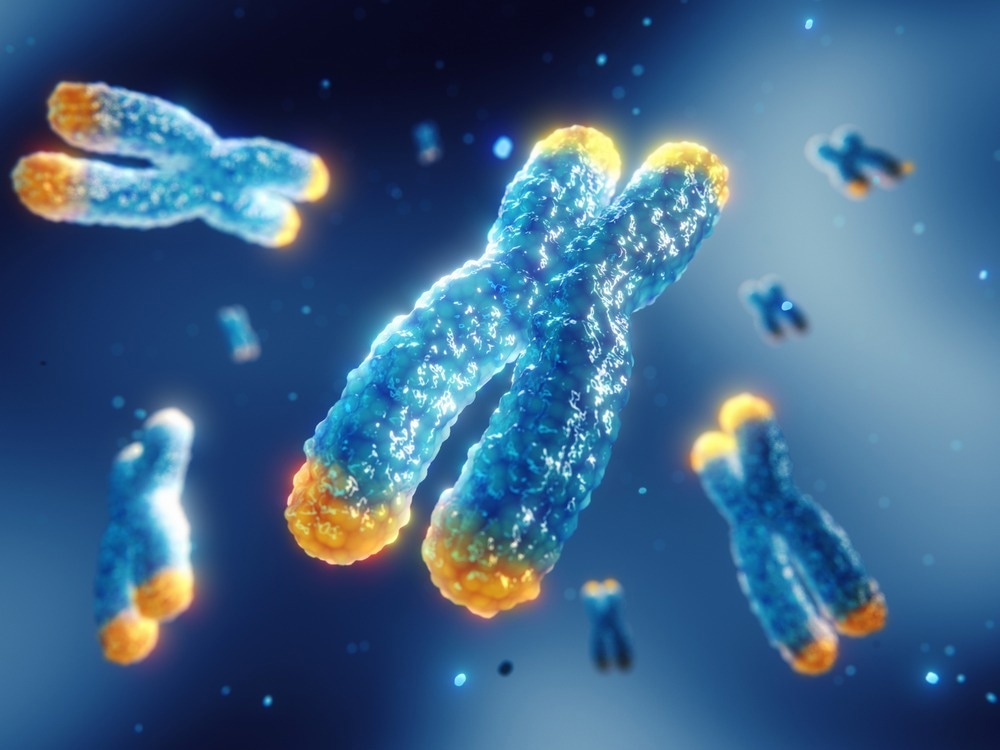Telomers represent the region that constitutes the end of chromosomes and is protected by telomere-binding proteins. These proteins protect telomeres from being recognized as DNA double-strand breaks. During somatic cell division, the end of the telomere cannot replicate by the lagging strand of the replication fork, causing telomere shortening after each cell cycle.
 Study: The alternative lengthening of telomeres mechanism jeopardizes telomere integrity if not properly restricted. Image Credit: nobeastsofierce/Shutterstock
Study: The alternative lengthening of telomeres mechanism jeopardizes telomere integrity if not properly restricted. Image Credit: nobeastsofierce/Shutterstock
If the cells continue to multiply, telomere attrition could induce cellular senescence. This phenomenon can be a barrier to tumorigenesis. Nevertheless, to attain replicative immortality, cancer cells overcome telomere shortening. This is achieved predominantly by activating telomerase or using a telomerase-independent but homologous recombination-based pathway associated with extending or maintaining telomeres. This mechanism is known as the alternative lengthening of telomeres (ALT).
Alternative lengthening of telomeres (ALT) cancers
ALT cancers achieve immortality by re-elongating telomeres in the G2 and M phases of the cell cycle via the break-induced replication (BIR) pathway. Previous studies have elucidated the toxic nature of the ALT mechanism. ALT telomeres are highly transcribed and rich in RNA: DNA hybrids (telR loops).
A decrease in the translocase FANCM, which is a highly conserved protein within the Fanconi anaemia (FA) tumor suppressor pathway, and depletion in the endoribonuclease RNAseH1 lead to an enhancement in telR loops, telomere instability, and ALT activity.
A recent PNAS study hypothesized that ALT might compromise telomere integrity if not restricted appropriately. It demonstrated that inhibiting telomeric repeat-containing RNA (TERRA) transcription can alleviate ALT activity. For this purpose, scientists deployed transcription activator-like effectors targeting TERRA promoters comprising specific CpG-rich, 29-bp repeats (T-TALEs) and fused them to a transcription suppression domain.
Key findings
A T-TALE C-terminally fused to a nuclear localization signal (NLS), the RNA polymerase II transcriptional activator VP64, and human influenza hemagglutinin (HA) epitope were developed. Scientists cloned the transgene downstream of doxycycline(dox) inducible promoter, which was used to develop two independent ALT, U2OS-derived clonal cell lines called vp6 and vp30.
Western blotting aided with anti-HA antibodies was used to validate the inducible transgene expression. Cells were treated with dox for 24 hours, and TERRA qRT-PCR was performed. TERRA transcripts from 29-bp-containing sub-telomeres were 3- to 10-fold higher than in untreated cells. However, TERRA from 29-bp-devoid of sub-telomeres remained unchanged.
Northern blot hybridization with probes was able to identify TERRA from the 10q sub- telomere or (UUAGGG)n sequences that consisted of all TERRA molecules, which exhibited an increase in TERRA species upon dox treatment. This finding indicates that this system can effectively improve TERRA transcription in U2OS cells.
The accumulation of the replication stress marker (RPA32) phosphorylated at serine 33 (pSer33), and the DNA damage marker histone H2AX phosphorylated at serine 139 (γH2AX) were monitored at telomeres. ALT was monitored by quantifying ALT-associated PML bodies, and events of de novo synthesis of telomeric DNA in the G2 phase were analyzed by EdU incorporation.
Dox treatments were not found to be effective on TERRA levels, telomere stability, and ALT. DNA fluorescence in situ hybridization (FISH) experiments revealed that inhibition of TERRA transcription enhanced the number of chromosome ends devoid of detectable telomeric DNA signals in the metaphase stage of the cell cycle. The findings documented in this study are consistent with a previous study that revealed TERRA transcription inhibition could improve ALT and promote progressive telomere shortening.
It was observed that the accumulation of telomere free ends (TFEs) in vp6 and vp30 cells, treated with dox for nine days, did not have any significant effect in nls1 cells. This finding indicated that a telomere loss mechanism, other than replicative shortening, could be activated upon elevated telomere transcription.
The current study revealed that dox treatment and structure-specific endonuclease Mus81 related to ALT telomeres enhanced the frequency of telomeric Mus81 foci in vp6 and vp30 cells. Depletion of Mus81 caused an increase in TFEs in nls1 and vp30 cells, which were not subjected to dox treatment.
A decrease in Mus81 prevented TFE accumulation in dox-treated vp30 cells without averting TERRA transcription induction or accumulation of pSer33 andγH2AX at telomeres. This finding suggested that Mus81 could play an important role in telomere loss events linked to enhanced TERRA transcription.
Conclusions
Based on the experimental findings of the current study and reports from other similar studies, the authors proposed a model for ALT-based studies. This study provided evidence and emphasized that the ALT mechanism is directly linked with molecular events that could endanger telomere stability. Hence, ALT must be appropriately controlled to allow telomere elongation and indefinite cellular division without excessive telomere loss. TERRA transcription has been identified as a versatile target for ALT cancer therapy.